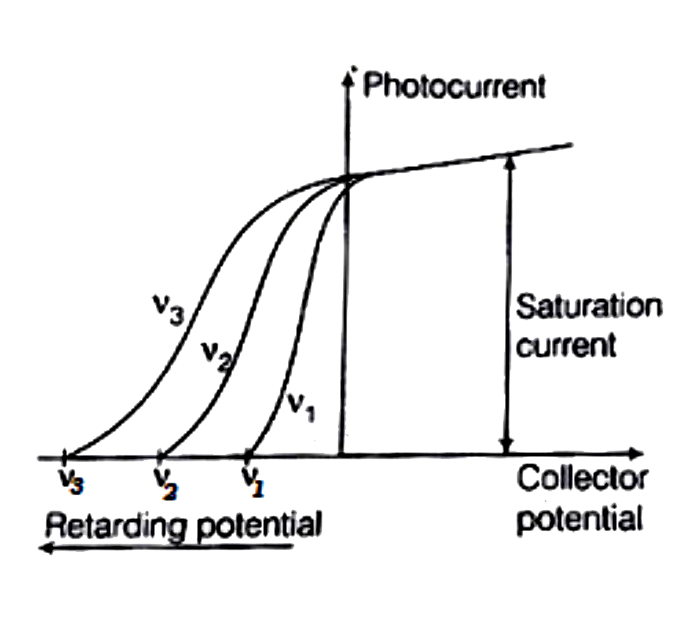When light of frequency v1 incident on a metal with work function W0 (where hv1>W0), the photocurrent falls to zero at a stopping potential of V1. If the frequency of light is increased to v2, the stopping potential changes to V2. Therefore, the charge of an electron is given by Solution in Marathi
W0(v2+v1)v1V2+v2V1
W0(v2+v1)v1V1+v2V2
W0(v2−v1)v1V2−v2V1
W0(v2−v1)v2V2−v1V1
The correct Answer is:C
Step by step video & image solution for When light of frequency v_1 incident on a metal with work function W_0 (where hv_1 gt W_0), the photocurrent falls to zero at a stopping potential of V_1. If the frequency of light is increased to v_2, the stopping potential changes to V_2. Therefore, the charge of an electron is given by by Physics experts to help you in doubts & scoring excellent marks in Class 11 exams.
Updated on:21/07/2023Topper's Solved these Questions
- ELECTRONS AND PHOTONSBOOK - TARGET PUBLICATIONCHAPTER - ELECTRONS AND PHOTONSEXERCISE - Evaluation Test
19 Videos
- ELECTRONS AND PHOTONSBOOK - TARGET PUBLICATIONCHAPTER - ELECTRONS AND PHOTONSEXERCISE - Critical thinking
22 Videos
- COMMUNICATION SYSTEMSBOOK - TARGET PUBLICATIONCHAPTER - COMMUNICATION SYSTEMSEXERCISE - Evaluation Test
15 Videos
- ELECTROSTATICSBOOK - TARGET PUBLICATIONCHAPTER - ELECTROSTATICSEXERCISE - EXCERCISE
156 Videos
Similar Questions
Relation between the stopping potential V0 of a metal and the maximum velocity of the photoelectrons is
View SolutionIf the work function of a metal is 'ϕ' and the frequency of the incident light is 'v', there is no emission of photoelectron if
View SolutionThe critcal frequency for sky wave propagation if maximum number density of electrons in ionosphere is 1010m−3 is
View SolutionElectrostatic means study of
View SolutionRadiations of frequencies v_2 and v_2 are made to fall in turn, on a photosenstive surface. The stopping potential required for stopping the most energetic photoelectrons in the two cases are V_1 and V_2 respectively. Obtain a formula for determining the threshold freqeuncy in terms of these parameters.
View SolutionPhotoelectric emission is observed from a surface for frequencies v_1 and v_2 of the incident radiation ( v_1 gt v_2 ) if maximum kinetic energies of the photo electrons in the two cases are in the ratio 1:K, then the threshold frequency is given by :
View SolutionWhen light of frequency v1 incident on a metal with work function W0 (where hv1>W0), the photocurrent falls to zero at a stopping potential of V1. If the frequency of light is increased to v2, the stopping potential changes to V2. Therefore, the charge of an electron is given by
View SolutionWhen light of frequency v1 is incident on a metal with work function W (where hv1>W) the photocurrent falls to zero at a stopping potential of V1. If the frequency of light is increased to v2, the stopping potential changes to V2. Therefore the charge of an electron is given by
View SolutionAt an incident radiation frequency of v1, which is greater than the threshold frequency, the stopping potential for a certain metal is V1. At frequency 2v1, the stopping potential is 3V1. If the stopping potential at frequency 4v1 is nV1 then n is
View SolutionThe variation of photocurrent with collector potential for different frequencies of incident radiation v1,v2,v3 is as shown in the the graph , then

View SolutionWhen light off frequency v_1 is incident on a photosensitive surface , the stopping potential is V_1 . If the frequency of incident radiation becomes v_1//2 the stopping potential changes to V_2 Find out the expression for the threshold frequency for the surface in terms of V_1 and V_2 If the frequency of incident radiation is doubled , will the maximum kinetic energy of the photoelectrons also be doubled ? Given reason .
View SolutionWhen the light of frequency 2v_0 where v_0 is threshold frequency is incident on a metal plate . the maximum velocity of electrons emitted is v_1 when the frequency of the incident radiation is increased to 5v_0 the maximum velocity of electrons emitted from the same plate is v_2 The ratio of v_1 " to" v_2
View Solutionv1 तथा v2(v1>v2) आवृत्तियों के आपतित प्रकाश के लिए धात्विक पृष्ठ से प्रकाश विद्युत उत्सर्जन प्रेक्षित किया जाता है। यदि इन दोनों स्थितियों में उत्सर्जित फोटो इलेक्ट्रॉन की अधिकतम गति ऊर्जाओं का अनुपात 1:k हो तो धात्विक पृष्ठ की देहली आवृत्ति होगी
View SolutionWhen the W function is connected to a metal v_1 When light of frequency (where hv_1 gt W) is incident, the current of light decreases. V_1 The insulating voltage is zero. Increases the frequency of light v_2 When done the inhibitory voltage changes V_2 Is. Then there will be an electron charge
View SolutionK.E. of photo electron is E when incident frequency is V1. It is 2E when incident frequency is V2. The relation between the frequencies is
View Solution
